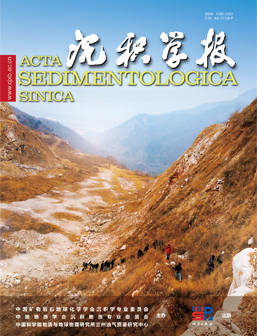Genetic Analysis of Multi-stage Carbonate Cementation in Shallow Burial and Geological Implications: Case Study of Shawan Formation of Neogene in the East Side of Chepaizi Uplift of the Junggar Basin
doi: 10.14027/j.issn.1000-0550.2024.092
- Received Date: 2024-05-21
- Available Online: 2024-09-18
-
Key words:
- carbonate cementation /
- shallow burial /
- cause analysis /
- geological implications /
- Neogene
Abstract: Abstract: [Objective] The first member of Shawan Formation of Neogene in the east side of Chepaizi Uplift of the Junggar Basin has serious carbonate cementation and strong oil-bearing heterogeneity. The formation reasons of carbonate cements in the study area are analyzed deeply, and their effects on reservoir physical properties and oil content are discussed. [Methods] On the basis of core observation, the types, distribution characteristics, formation stages and genesis of shallow buried carbonate cements were studied by using the methods of observation and identification from thin sections, cathode luminescence (CL) analysis and X-Ray Diffraction (XRD) analysis. [Results and Discussions] The results show that there are at least three stages of carbonate cements in the first member of Shawan Formation. The carbonate cements in the first stage are mainly dominated by shell-like calcite and granular siderite. Under polarizing microscope, it can be observed that the edges of some mineral particles are replaced, and the continuity of cement is poor due to the influence of acidic fluids in the later stage. The results of cathode luminescence show that the calcite is bright yellow. The formation of carbonate cements is mainly influenced by paleo-climate and sedimentary water. The local area of the study area was influenced by the development of algae. The second and the third stage of carbonate cements are dominated by poikilitic calcite, of which the second-stage calcite is widely distributed. The results of cathode luminescence show that the calcite cement of the second stage is almost non-luminous and has the characteristics of high magnesium, while the calcite cement of the third stage is orange yellow. Under polarizing microscope, there are obvious corrosion marks at the boundary between the second and third stage of calcite cements. Both of the second and the third stage of carbonate cements are affected by hydrocarbon generation and expulsion from the middle and lower Jurassic source rocks in Changji Depression. Organic acid fluid dissolved the early carbonate cements and acid-soluble particles, providing the main material source for the development of subsequent carbonate cements. It is found that carbonate cement causes the poor physical properties of Shawan Formation reservoir in the early stage. The porosity and permeability of the reservoir are limited improved by the injection of acid fluid in the later stage. When the carbonate cement develops continuously in the plane, it forms thin inter-layers sealed by capillary pressure. Thin inter-layers formed by carbonate tight cementation control hydrocarbon migration and trap types in the reservoir to a certain extent. The tight cementation of carbonate effectively blocks the migration path of oil and gas, and oil and gas can only migrate and accumulate along a few structural fractures, which leads to obvious oil heterogeneity in the same set of sandstone in the study area. In addition, when the carbonate cements developed in the reservoir have large distribution area and high content, appear on the top of the sand body and most of them are basement cementation, a better cap layer will be formed, which will affect the accumulation of oil and gas to a certain extent. [Conclusions] The types, distribution characteristics, formation causes and geological significance of multistage carbonate cements are defined in the paper, which provides support for continuous exploration and development and searching for new exploration targets.
| Citation: | Genetic Analysis of Multi-stage Carbonate Cementation in Shallow Burial and Geological Implications: Case Study of Shawan Formation of Neogene in the East Side of Chepaizi Uplift of the Junggar Basin[J]. Acta Sedimentologica Sinica. doi: 10.14027/j.issn.1000-0550.2024.092 |






 DownLoad:
DownLoad: